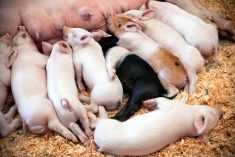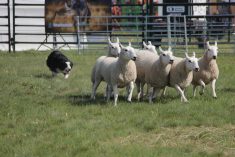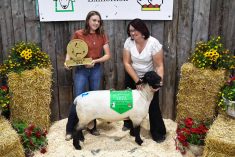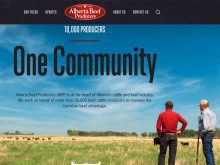AIRDRIE, Alta. – Last winter when Hazel George received a call from the SPCA she assumed the worst.
“I thought oh-oh, is there something dead out there I didn’t see?”
Instead the caller told her she was Alberta SPCA farmer of the year for 1996.
Taking good care of the stock goes back to her childhood when George lived on an acreage outside of Regina.
“It was ingrained into me early in life that I must care for my animals if I was going to have them. Nobody else was going to look after them,” she said.
Read Also

First-time pig mothers may need more lysine
Lysine feed recommendations may fall short for gilt pregnancies when it comes to making sure the mother pig can produce as much milk for her piglets as possible
An SPCA representative toured every corner of her farm northeast of Airdrie where he not only checked her cattle, but her treatment of all the farm animals including the dogs and cats.
At Sagewood Farms, Hazel is in charge of the purebred Charolais operation, while her husband Pat and son Charlie Roe work in Calgary.
She believes careful management produces sound, well tended cattle.
She has raised Charolais for 22 years and has always kept meticulous records on performance, health and calving for each animal.
She knows when calves are due to be born and uses a video camera in the calving barn to monitor a cow’s progress and the calf’s vigor after it is born.
To reduce stress, calves are inoculated, tattooed and dehorned within the first 24 hours of life.
“I recognize that’s a purebred privilege. People can’t do that when they run 200 head out on the prairie,” she said.
There’s lots of bedding, clean water and minerals available.
Friendlier halter
Hazel uses a modified horse halter to halter break the calves. Her system cuts down irritation around the animals’ mouths and ears compared to a rope halter. Halter breaking starts after weaning.
She uses a soft weaning program where calves are taken off their mothers gradually. The calves are kept in familiar pens and receive the same grain rations that they were offered from birth.
“I’ve had a lot more success weaning that way rather than having to rely on a lot of drugs to reduce shipping fever. I have very little sickness in the fall.”
To further reduce stress she doesn’t brand cattle and drugs are administered just below the skin, in the neck whenever possible. Needles and other equipment are always kept scrupulously clean.
“I prefer, and I’m happy to see these subcutaneous drugs coming out because it is just so much less stress on the animal,” she said.
George believes it doesn’t cost any more to follow a program of whole herd health and routine cleanliness.
“It’s a proactive system rather than a reactive system. It costs me less in drugs and time to treat an animal that is sick.”
She depends on these cattle for her livelihood so they must be the best she can make them. Marketing is never easy because there is so much competition among bull producers. She consigns bulls to the Calgary Bull Sale, a private sale and off-farm sales.
“You’ve got to have good product, you’ve got to be proud of it and have all the statistics the people want,” she said.
“You can make all the smoke and mirrors you want at the shows and sales but in the end, the good cattlemen will still know the good cattle.”
As long as cows keep producing, they stay on the farm. Longevity, good feet and legs, and good temperament are most important to her.
Gentle temperament
Most of the time George works by herself on the farm so the cattle must be easy to handle. The importance of gentleness among her cows and bulls was reinforced eight years ago when a new mother cow trampled her.
In addition to tending her cattle as well as she can, she has started some environmental projects to protect a fragile native pasture and waterway.
She uses a horse to work with her cattle because the pastures can’t sustain vehicle traffic.
There’s no hunting allowed on her property as she works with Alberta Environment and a local conservation club to restore a reclaimed gravel pit and upgrade the creeks to provide good water for her cattle and wildlife.
Cow crossings were established so creek banks don’t get crushed and she is building a wildlife habitat in one of the pastures that holds some duck ponds. The area isn’t used for pasture until July when the birds are finished nesting.
“I try to look after the environment so the wildlife can look after themselves without interference from the cattle.”
She has started taking before-and-after pictures to share with other farmers in the future.
“We’re trying to show people how easy it can be done,” she said.















